2011 KTM 250SXF MOTOCROSS TEST: THE BIKE THAT WON THE 250 WORLD CHAMPIONSHIP; WITH LINKAGE AND FUEL INJECTION
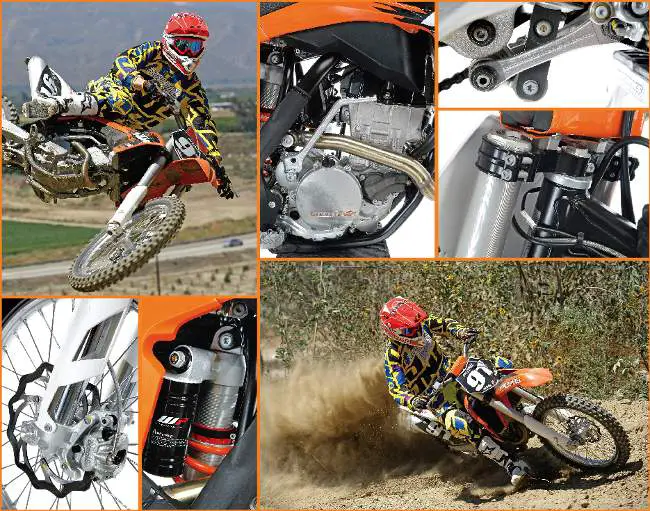
Q: FIRST AND FOREMOST, IS THE 2011 KTM 250SXF BETTER THAN THE 2010 KTM 250SXF?
A: Yes. The one aspect of past KTM 250SXFs that we always hated was the linear, No-Doz powerband. It made lots of horsepower, but you had to wait for it. It was a no-hit, long draw-out, high-rpm powerband. In the hands of a really fast rider it could go really fast, but in the hands of an average rider it wasn’t so fast. Thankfully, the new fuel-injected 2011 KTM 250SXF doesn’t require any patience. It has an actual you-can-feel-it powerband.
Q: WHAT ARE THE BIGGEST CHANGES MADE TO THE 2011 KTM 250SXF?
A: Let’s get down to business. KTM focused on four areas of improvement with the 2011 KTM 250SXF.
(1) Linkage. KTM skeptics can rejoice in the fact that the Austrians went from a no-link PDS shock to a complete linkage system. Why? Popular opinion. Many people believe that the no-link idea was the cockroach in KTM’s kitchen. In reality, KTM was very close to perfecting the PDS system. We will miss the simplicity, reduced weight, and ease of working on the no-link system because with the exception of the contractive feel of the linkage it feels very much like the old system. Why? Because the engineers and test riders that tested and approved the no-link PDS suspension system are the same ones who fine-tuned and worked on the new linkage system. Guess what? They worked on it until it felt like the suspension that they liked?PDS.
(2) Electronic fuel injection. Everyone else is doing it, so why not KTM? In all seriousness, KTM has been tinkering with fuel injection for several years?long before it became a production part on their SXF models. The 250SXF comes with a Keihin 42mm throttle body with a five-probe sensor that reads the manifold pressure, water temperature, throttle position, airbox temperature and fuel pressure. It should be noted that KTM, like Kawasaki, has coined their own name for electronic fuel injection. Kawasaki calls it DFI (Digital Fuel Injection), while KTM labels it EMS (Engine Management System). When you hear EMS or DFI, think EFI. Confused yet?
(3) Chassis. KTM revised the swingarm to work in conjunction with the linkage using a single-component casting process. The basic frame designs of the PDS and linkage systems are similar; however, the big difference is the tower placement of the upper shock mount. KTM’s goal was to isolate the shock and transfer energy better. The frame’s geometry is very similar to the previous frame design’s, including the steering stem angle and footpeg mounting bracket locations.
(4) Engine. The 2011 KTM 250SXF underwent a substantial number of engine changes aimed at improving bottom-end and midrange power. For starters, KTM shortened the valve timing, changed the shape of the inlet ports, adjusted the cam splay, and modified the intake and exhaust port openings. The radiator system was rerouted with a T-connector that passed through the frame triangle. KTM made the muffler outlet diameter larger by 3mm and decreased the overall length by 35mm. The head pipe was tapered. A note of interest is that the shorter 250SXF muffler will fit on the 2011 350SXF and 450SXF (which should give either bike a midrange boost).
Although the 250SXF doesn’t come with an electric starting system, the bike will accept KTM’s bolt-on electric starter kit. The unit will add weight to the 250SXF, but it’s a small price to pay for efficient starting when it matters most.
Q: HOW DOES THE 2011 250SXF COMPARE TO LAST YEAR’S MODEL ON THE DYNO?
A: Maximum horsepower on our 2011 KTM 250SXF was 36.41 ponies at 10,800 rpm. Maximum torque was 19.96 foot-pounds. For comparison, our 2010 KTM 250SXF was a half horsepower stronger at 36.90 horsepower at 12,200 rpm, but made less torque at 19.33 foot-pounds.
Overlay the dyno curves of the two models and you will see that the 2011 powerplant has a one horsepower advantage from 5500 rpm to 8500 rpm. At that point, the 2010 engine closes the gap. But then at 10,000 rpm, the 2011 KTM 250SXF kicks into overdrive and trumps the old engine by nearly two ponies. It isn’t until 11,300 rpm that the 2010 engine makes its orbital ascent and rockets past the 2011 engine.
What does all of this mean? For starters, the 2011 KTM 250SXF has better power, and that power is positioned closer to the meat of where a powerband should be. Unlike in years past, the 250SXF engine actually has a hint of a curve. In previous years, there was no curve?just a straight line from top-to-bottom. Linear may look good on paper, but a curve is better on the track. The dyno shows that the 2011 powerplant actually has bottom end, midrange and top?as opposed to top only.
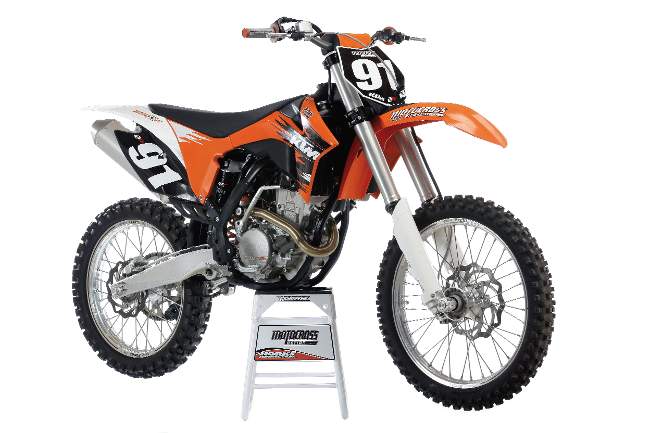
2011 KTM 250SXF: For the new model year KTM pumped up the powerband, added electronic fuel injection and a linkage system. From outward appearance it’s easy to discern the 2011 KTM 250SXF from previous models, thanks to radically new body styling.
Q: IS THE 2011 KTM 250SXF FASTER THAN THE 2010 KTM 250SXF ON THE TRACK?
A: Yes. In previous years, the KTM 250SXF has produced the most horsepower of all 250 four-strokes, but it reached peak performance well beyond the scope of normal riding conditions. No one, including James Stewart, rides a motorcycle full-tilt at 12,000 rpm for more than a few seconds over the course of a moto.
KTM’s in-house test riders requested more bottom-end and midrange hit with the 2011 250SXF. KTM’s engineers acquiesced. As a result, the updated engine is significantly stronger in those target areas. The engine didn’t receive a complete overhaul, meaning that there are still several powerband traits that are shared with the previous engine. What are those traits?
(1) Off idle, the 250SXF is still sluggish as it builds power.
(2) There isn’t an explosive hit anywhere in the powerband. No MXA test riders described the 250SXF as having a linear powerband, but instead felt that it was a much more effective engine that was built for racing. This speaks volumes for a bike that was considered best suited for the drag strip a year ago.
(3) On the downside, while KTM may have finally produced a better powerband, they need more punch?a defined hit. Most test riders prefer an engine with a lively personality (if an engine can be personified)?the KTM 250SXF doesn’t sparkle. It is still a wallflower. But with that said, the KTM 250SXF is well-suited to Intermediate- and Expert-level riders who attack the track and keep up the rpm.
Q: HOW WELL DOES KTM’S FUEL INJECTION WORK?
A: Let’s take you through our brief, but storied history of fuel-injected 250 four-strokes. The first EFI bike was the 2010 Honda CRF250. To put it bluntly, the CRF250 transformed from a screeching power monger into an engine that was as flat as William Hung’s voice. Next came the 2010 Suzuki RM-Z250, which as a carbureted bike had tons and tons of low-end power and little else?it got better with fuel injection because it couldn’t have gotten more single-minded than it was. As for the fuel-injected 2011 KX250F, the powerband wasn’t as strong as last year’s carbureted model. To clarify, we haven’t been overly impressed with fuel-injected 250 four-strokes.
That is, until now! The fuel-injected 2011 KTM 250SXF is very good. What’s interesting is that while the aforementioned bikes had tremendous hit and power through the midrange before being equipped with EFI, the KTM 250SXF lacked these traits. In effect, KTM went in the opposite direction of Honda and Kawasaki. In place of its linear powerband, the KTM 250SXF received a swift kick in the guts. The engine produces decent power down low and builds steam into the midrange. At that point, a rider can either shift into the next gear or hold on as the engine rockets into the top end. The preferred method is to wind the engine out, but the 250SXF has enough torque to carry a higher gear.
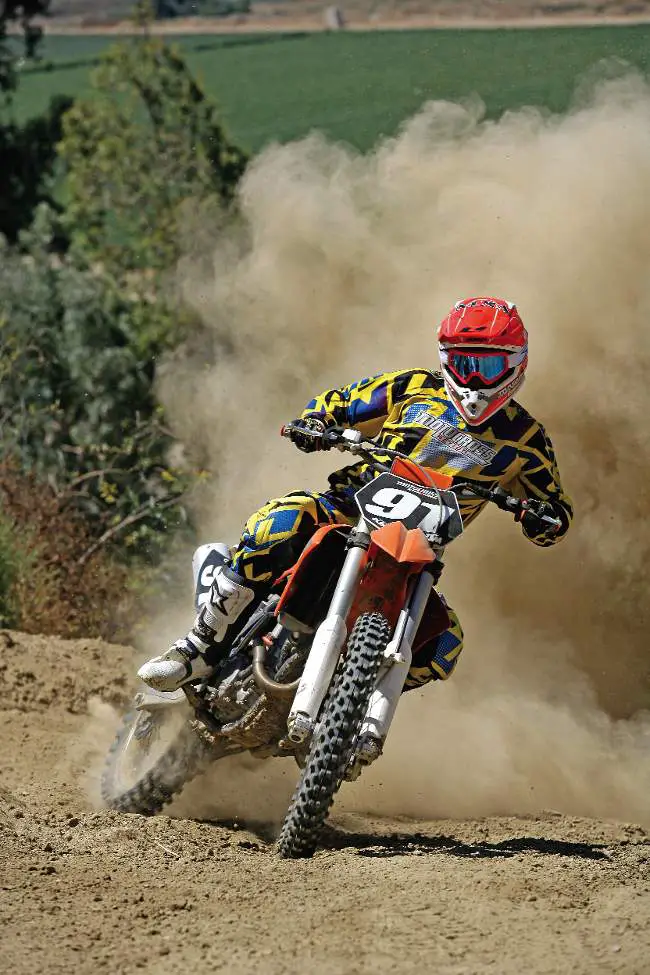
Pros and cons: We enjoyed the revised engine characteristics, electronic fuel injection, brakes, triple clamps and clutch. However, we found trouble with the spring rates, dragster gearing, and soft rims.
Q: DOES THE 2011 KTM 250SXF PASS THE AMA SOUND TEST?
A: We figured that the KTM 250SXF would breeze through both the FIM two-meter-max and AMA sound tests. After all, KTM is very serious in their quest to lower the sound output of their bikes. European racers should rejoice, because the 2011 KTM 250SXF puts out a relatively low 106.8 dB on the FIM scale (115 dB is the maximum allowed). However, the 250SXF skirts the AMA’s legal line at 95.2 dB. The mandated sound level in the U.S. is 94 dB, but the AMA allows almost a 2 dB leeway (just as with every other rule they ever made) hat allows up to 95.9 dB to pass the test. Thus, the KTM 250SXF is legal.
As mentioned previously, KTM made the outlet diameter on the 250SXF muffler larger to improve performance. This should not have helped them make the bikes quieter, but KTM was able to lower the sound output of the bike by making incremental engine changes that decreased engine noise. Eureka!
Q: ARE WE FANS OF KTM’S NEW LINKAGE SYSTEM?
A: We can tell you with certainty that we weren’t always in favor of KTM’s against-the-grain no-link system, but not for the reasons that you might think. KTM has been zeroing in on the proper rising-rate ratio and ironing out the kinks that came with the no-link system, making improvements every year of production. In 2010, KTM had a near winner in their no-link design, aside from the shock’s inability to absorb square-edged chop with ease.
We had heard for years that the Austrians were going to make the switch to linkage, but it was more hearsay than actual fact. Now, the proof is in the pudding. After years of research and development behind closed doors, WP’s all-new linkage system is on the market. WP’s KTM design was modeled after Yamaha’s system?right down to the rising rate. And why not? Yamaha has the shock game figured out. KTM put their faith in linkage, evidenced by the fact that it comes on the 250SXF, 350SXF and 450SXF (the two-strokes still come with the no-link system).
With that said, do we like WP’s new system? Yes, but there’s a caveat. Given the right spring rate, we would love the linkage system. Unfortunately, KTM spec’d the 250SXF for a rider who weighs as much as a Ruffed Grouse. The bike is undersprung for anyone over 150 pounds. We jumped up a spring rate and were satisfied with the results. Best of all, the rear end no longer suffered from the dreaded step-out reaction that occurred on no-link KTM 250SXF models in nasty braking bumps.
Q: WHAT ARE MXA’S RECOMMENDED KTM 250SXF FORK SETTINGS?
A: Here is what the MXA wrecking crew ran in its 2011 KTM 250SXF (stock settings are in parentheses):
Spring rate: 0.48 kg/mm (0.46 kg/mm)
Oil height: 360cc (380cc)
Compression: 13 clicks out (12 clicks out)
Rebound: 12 clicks out
Fork leg height: 5mm up
Note: When the forks are new, they need about an hour of riding to break in.
Q: WHAT IS MXA’S RECOMMENDED KTM 250SXF SHOCK SETTING?
A: Here is what the MXA wrecking crew ran in its 2011 KTM 250SXF (stock settings are in parentheses):
Spring rate: 5.7 kg/mm (5.4 kg/mm)
Race sag: 102mm
Hi-compression: 2-1/4 turns out
Lo-compression: 18 clicks out (15 clicks out)
Rebound: 15 clicks out
Note: The shock is very sensitive to race sag. For rider who are under 150 pounds, the stock shock spring is okay.
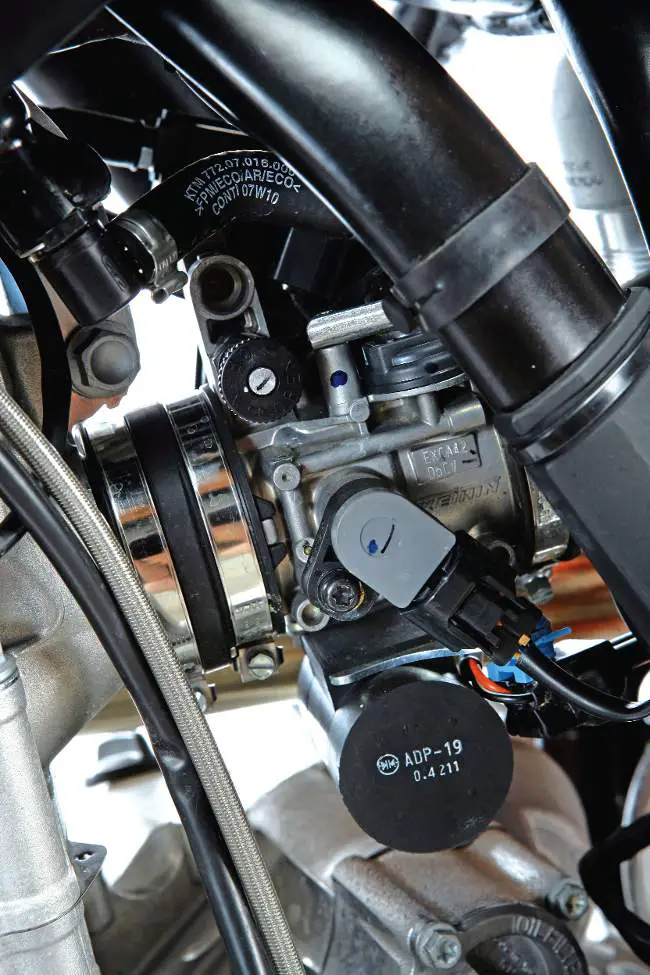
The Keihin Fuel injection system.
Q: WHAT DID WE DO TO MAKE THE KTM 250SXF WORK BETTER?
A: Depending on rider skill level and weight, there are three areas that need to be addressed in order to maximize the effectiveness of the 2011 KTM 250SXF. Let us count the ways:
(1) Forks. The 48mm WP USD forks are undersprung for any rider faster than a Novice or heavier than 150 pounds. Just as in previous years, we utilized stiffer springs to keep the forks up in their stroke while dropping the oil height to reduce midstroke harshness. If you go this route, we recommend that you decrease the oil height in 5cc increments until you’re happy with the performance of the forks.
(2) Shock. It’s not that we dislike KTM’s new linkage system. It’s more that we dislike their shock spring choice. KTM used a very soft shock spring, which became a nuisance for faster riders. Jumping up a spring rate yielded a shock that used the entire stroke effectively and balanced out the bike.
(3) Gearing. Once again, we had to play the gearing game with the 250SXF. In stock trim, the bike comes with a 48-tooth rear sprocket. We geared it down by switching to a 49-tooth rear and came away happy with the engine’s ability to pull second and third gears. It should be noted that we tried adding two extra teeth on the rear but didn’t like the outcome. Only on very tight tracks should you need a 50-tooth rear sprocket.

Q: WHAT DID WE HATE?
A: The hate list:
(1) Gearing. It’s the same old song and dance with the KTM 250SXF. Add a tooth to the rear sprocket to close the gaps between gears.
(2) Bar mounts. Shorter riders will get along fine with the stock handlebar mounts, but tall riders should invest in 5mm taller bar mounts. These mounts are available through KTM’s massive parts catalog.
(3) Suspension. If you weigh more than 150 pounds, we strongly suggest that you go stiffer with the shock and fork springs. It’s a small price to pay for a much better performing suspension.
(4) Rims. It’s rare that we complain about Excel rims, but the first run of production KTM 250SXFs have soft Excel rims. We were constantly chasing the spokes around the rim to keep them tight. KTM and Excel say that there is no problem with the rims, but we have been tessing motorcycle for decades and never had to chase so many spokes or flat-spotted so many rims at the rim locks.
(5) Fuel pump routing. Every test rider enjoyed KTM’s fuel injection system, save for the unusual fuel pump routing inside the gas tank. On our 250SXF, the routing blocked part of the tank’s fill hole, making it difficult to pour gas into the bike. we think that the fuel pump was put in the gas tank reversed.
(6) Preload adjuster. We don’t like it?and you won’t, either.

Sans every other part the 250SXF engine is small and compact..
Q: WHAT DID WE LIKE?
A: The like list:
(1) Powerband. The 250SXF’s powerband has been moved more toward the bottom-end and midrange. Hallelujah! This engine romps last year’s linear moon shuttle.
(2) Fuel injection. Crisp and clean, the fuel-injection system didn’t neuter the 250SXF powerband. The only downside to the EFI system, along with the shock linkage, is that it tacked on five extra pounds. Even so, it’s a fair trade.
(3) Clutch. You can’t beat Brembo’s self-adjusting hydraulic clutch. It’s a no-nonsense item that works consistently and effectively.
(4) Brakes. KTM has the best brakes in the business. Test riders absolutely loved the Brembo/Galfer combination, because we could go deeper into corners. The 250SXF has tremendous pucker power.
(5) Triple clamps. KTM makes the best triple clamps?period. With four different handlebar mounting positions, flex characteristics taken into account, an equal clamping surface and torque specs etched into the surface, these clamps are trick.
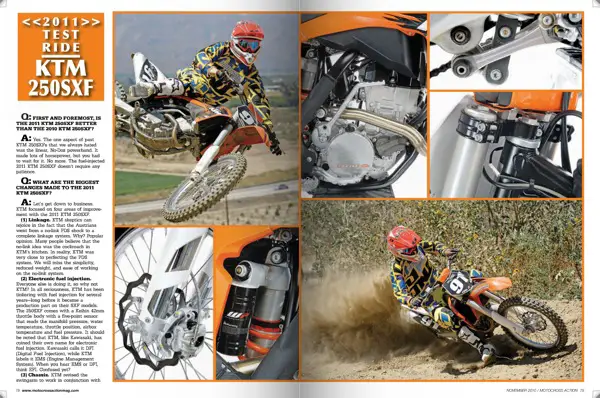
Q: WHAT DO WE REALLY THINK?
A: Is the 2011 KTM 250SXF better than last year’s bike? Yes. We found happiness in the improved powerband, all-new electronic fuel injection, linkage system and handling. But, there were several downsides. The suspension is undersprung for faster riders. The gearing is off. The weight is up, and there are several quirky issues with the bike.




Comments are closed.